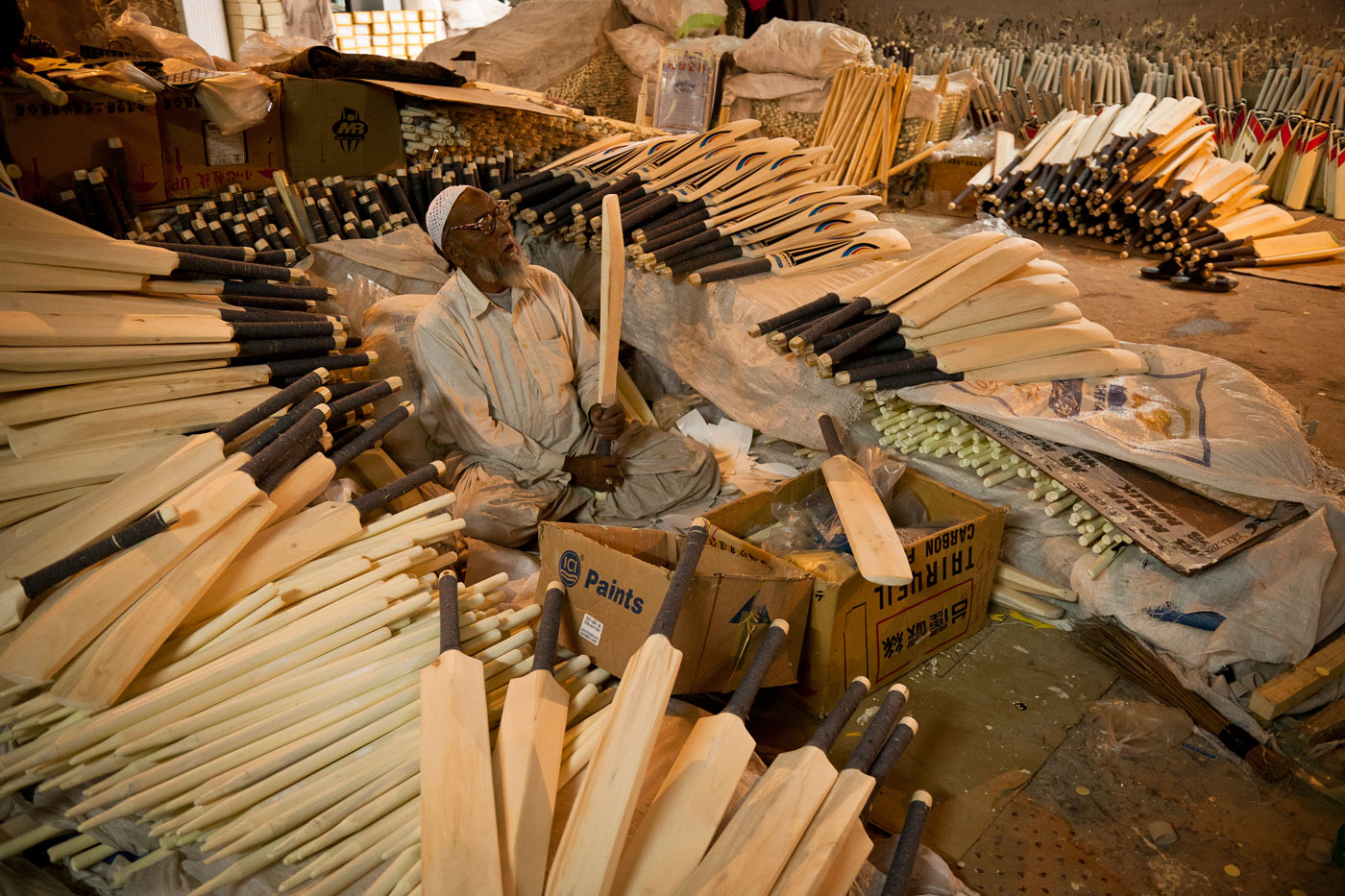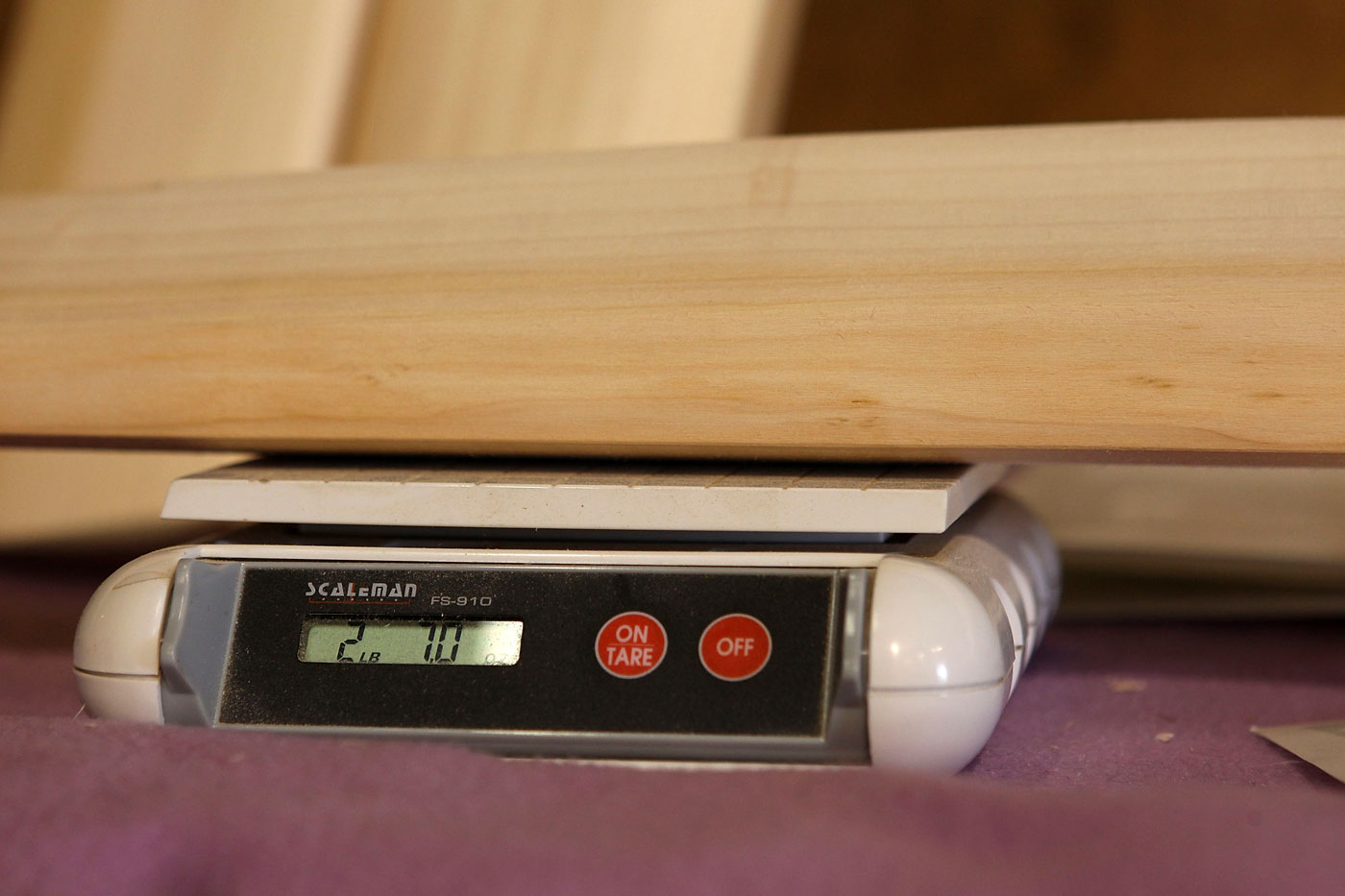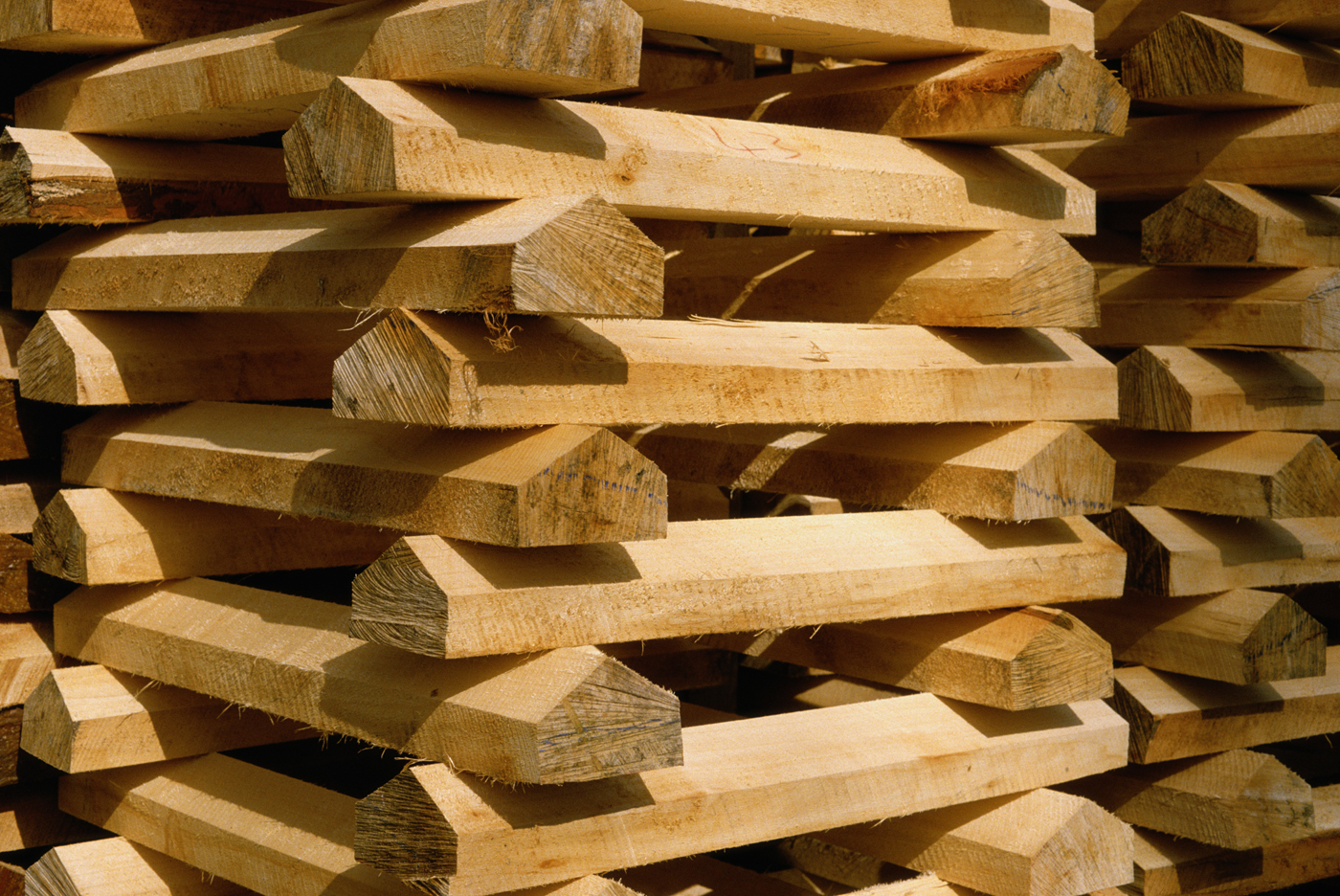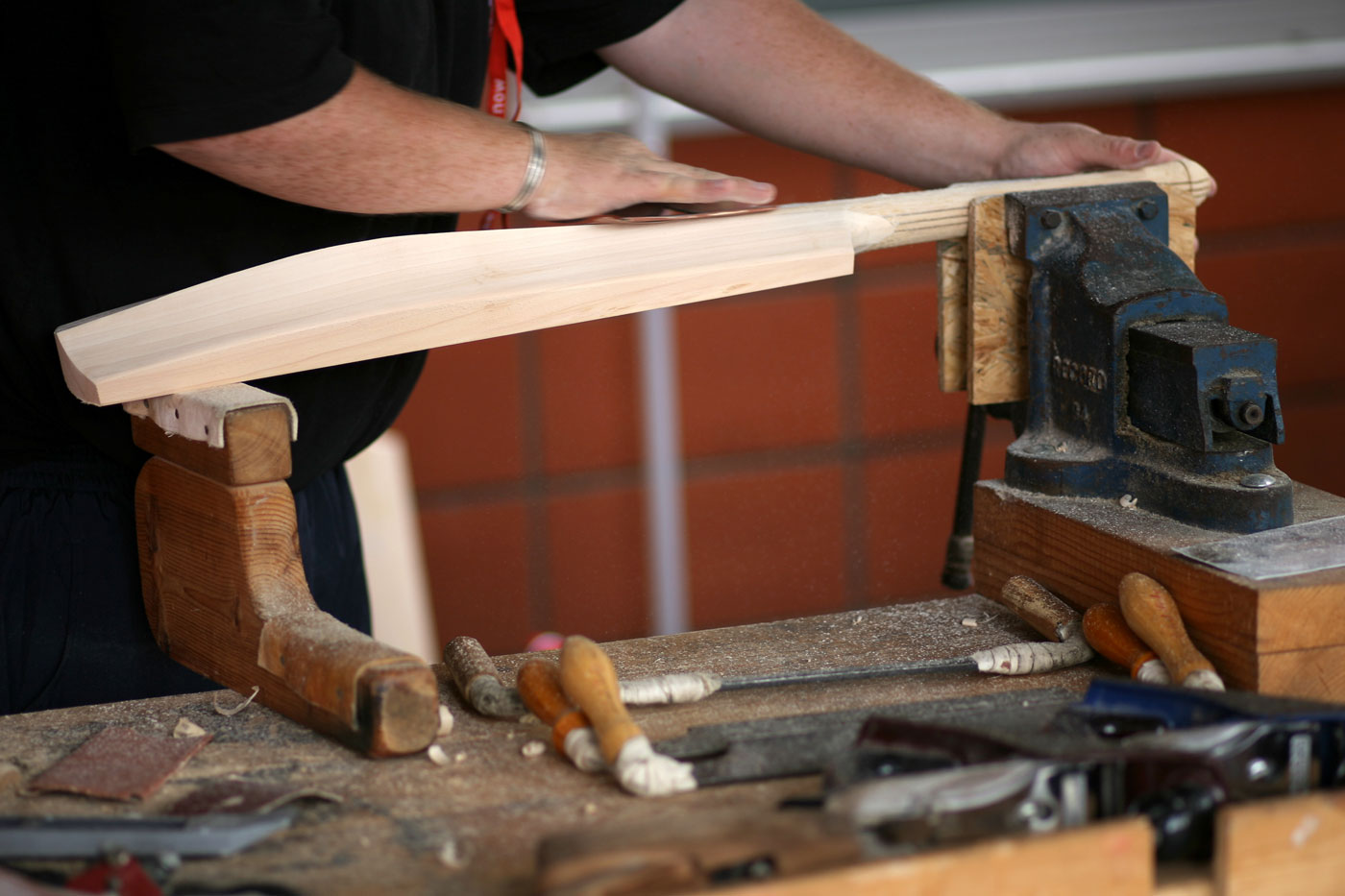The psychology of bat-making
Posted by Jon Hotten on 8th Oct 2014

A worker makes bats in a factory in Sialkot © Getty Images
"That's Virat Kohli's bat…"
It was the drinks break during a game on one of the hottest days of the summer. We were playing at Chalke Valley, the glorious green postage stamp of a ground hidden at the end of a lane by a church near a tiny village in Wiltshire. It was about as far as you can imagine from the fevered bowls of the Wankhede or the Kotla, where Kohli scores his runs, and the bat had been passed through various, mysterious hands to the player who had it now, the vice-captain of a Mumbai club side called Osian's, who were touring England at the same time as the Indian national team.
I picked it up. What magic did it hold? Was it real? The handle was thick, the blade bone-white. It was a handsome thing, but then so were lots of bats. What set it apart was the contrast between the overall feeling of size and power and the weightlessness of its pick-up. It was almost as if the wood wasn't willow at all, but balsa or some other drier, less dense substance.
****
Chris King trained as a cabinet-maker and antique restorer before spending the next 15 years of his working life as an artist, photographer and university lecturer. He was looking to get back into woodworking when he replied to an opaque advertisement placed by an employment agency for "a wood craftsman with an interest in sport". He answered five questions on the phone about cricket ("What's the name of Hampshire's ground - that sort of thing…"), then had an interview with the agency and a third interview with Neil Gray and he landed a job that many would covet: that of a master bat-maker at Gray-Nicolls, the Sussex company that has in the little museum in its factory in Robertsbridge the bats they made for, among others, WG Grace and BC Lara.
King had never made a cricket bat, but for a cabinet-maker it is not a complicated object to shape and join. Instead the art of producing a good one is about judgement of the wood and an understanding of its purpose, both physical and psychological. One of the things he realised quite quickly was how misunderstood the product and the process were, not just by fans, but also by ex-players, commentators, journalists, everyone. He had seen a tweet that I'd sent after picking up Kohli's bat - something about how lightly it must have been pressed to feel the way it felt - and he replied to say the way Kohli's bat felt had very little to do with the way that it was pressed, and what's more, almost everything that people who wrote and talked about "big bats" and their effect on the modern game was wrong, or at least only half-right.
Now we were sitting in the bright showroom at Gray-Nicolls, some new bats, gleaming and huge, hanging on the walls beside us, about to dispel the myths that exist about them.
| "Nowadays, bats are big but they are light. And what we're up against is the belief that a big bat is more powerful than a bat of the same weight that's smaller, which it isn't. That's against the laws of physics"Chris King, bat-maker at Gray-Nicolls | |||
"It's a common misunderstanding that the size of a cricket bat makes a difference," King begins. "When we talk about size, we're talking about the physical dimensions of the bat as opposed to the weight or the mass. Because that's where people can get a little bit confused. In the days of Botham or Clive Lloyd, for example, who had a three-and-a-half pound bat - that's a hefty lump of willow. Nowadays bats are big but they are light, as you found with Kohli's. And what we're up against is the belief that a big bat is more powerful than a bat of the same weight that's smaller, which it isn't. That's against the laws of physics."
****
For the century or so after Grace and Fry and Ranji led the game into its first golden age, the cricket bat remained essentially unchanged. The shape was simple; a master bat-maker could produce 80 a day. It wasn't until the 1970s that a functional object became something new and desirable, something marketable and memorable.
Television played a role. Cricket went through its futuristic shiver with Kerry Packer and bat design got funky. Into the hands of the game's big players came the Gray-Nicolls GN100, known universally as the Scoop; the Stuart Surridge Jumbo; the Slazenger V12; the Duncan Fearnley Magnum. Dennis Lillee walked out to bat with the aluminium ComBat and got the laws of the game rewritten.
Cricket bats were transformed into objects of fetish, things to be aspired to, coveted, cherished. They became associated with particular batsmen and particular innings. They were part of the iconography of an era. The Scoop and the Jumbo, in particular, were daring experiments in form, the first bats in history to deviate from the standard design, and the emotional response they produced among their users suggested a psychological element to the relationship between player and bat that had not really been considered before.

Today's big bats weigh less than the ones used by Clive Lloyd and Ian Botham © Getty Images
But the cricket bat had not yet taken its great leap forwards. Pictures of players from the start of the 21st century show that the object was still traditional, slender-edged, flat-faced. Indeed the fashion had moved away from hollowed backs and loaded spines to something less outré.
The first intimations of change came in India, where batting is worshipped and many of the most skilled podshavers work with willow shipped from England. Here, at last, the bat began to respond to the psychological urges of the player using it. The blade was given an inward bow; instead of being a flat, sometimes convex surface, it took on a visually pleasing curve. That curve was mirrored on the sides of the bat, where the back edges swooped outwards at the middle. And on bats made for Indian pitches that middle was not really in the middle at all but a few degrees lower, giving the impression of deepening power as the player looked down on it.
The extra wood needed to come from somewhere. If the bat had simply been made bigger with no other change in method, it would have taken Chris Gayle to lift it. The older bats like the Jumbo and the Magnum that this new design was starting to dwarf were solid and heavy. The new bats had greater size but their density was different. The moisture content was lower, the pressing less firm, and wood shaved from the shoulders and the first few inches of the bat allowed more for the middle and on the edges.
It became an illusion of weight if not size. Grace once said that his own blade, which weighed 2lbs 5.5oz, was "heavy enough for any man". The modern pros mostly favour something between 2lbs 8oz and 2lbs 10oz. Even Gayle's railway sleeper, said to tip the scale at 3lbs, weighs less than the Jumbo of Graham Gooch or the Magnum of Clive Lloyd.
****
To understand a bat, you must understand the life and death of the wood that it is made from. Salix alba or White Willow is one of almost 400 species in the Salix genus. It is a deciduous tree that likes the damp soils and cold, temperate climate of the northern hemisphere, specifically England, where it can access the volume of moisture that it needs to feed and grow. Its roots are large and tenacious and take readily. The trunk of Salix alba is a complex network of tubes designed to draw water upwards to the leaves as efficiently as possible. It is fast-growing and retains large amounts of carbon dioxide, meaning it's often used for biofuel and grown beside motorways to air-scrub pollution. The wood it produces is tough yet pliable, and man has always known it - willow tools have been dated to 8300 BC.

Cut willow being dried in the Gray-Nicolls factory in Robertsbridge © Getty Images
Although other types of the genus, most notably Kashmir Willow, have been used to make cricket bats, and other woods with similar density like poplar have been tried, Salix alba grown in England now provides the wood for every high-grade cricket bat in the world. Its comparative rarity means that the industry, and by extension the sport, is vulnerable to fungi and disease of the kind that caused Dutch Elm Disease and Ash Dieback. Some arborealists say that it is only a matter of time before such a plague comes to willow, although no one can say for sure how or when.
Bat-makers face more prosaic problems too. Gray-Nicolls is one of the only companies that grows its own willow, but even they are dependent on access to the fields at certain times of the year, and the weather and wet ground can turn against them.
The trees are usually harvested between the ages of 15 and 20 years. The grains that appear on the bat face are the growth rings of the trunk, each one measuring 12 months of outward expansion. The narrower the grain, the less size the tree's circumference has gained in a year, thus bats with a tight grain come from the slowest-growing trees. A very dark grain indicates a dry summer - veteran bat-makers can still spot a bat that was growing in 1976, the year of a famous English heat wave.
We walk into the yard to look at some newly felled willow. Up close, the trunks are huge and solid, movable only with heavy machinery. The bark is an inch thick and when I put my hand on it, damp to the touch. The wood itself is a dark yellow, full of water and sap. It's easy to see why bat-makers laugh at some of the more common myths that they hear: that the best willow comes from Essex because it's windy out there in the flatlands and wind creates more tension in the wood; or that a rainy year makes more weaknesses in the grain. These trees are big, heavy and wet; they have evolved over thousands of years to thrive in rain and wind and cold. It's not nature that pushes the wood to its limits, it's us.
The trunks are cut into three-sided clefts around the length of a blade. Still full of moisture, swollen and rough-edged, it takes two hands to lift one. They are stacked in the high drying sheds, where they begin to shrink and whiten as they lose volume and water. Slowly a cleft becomes more recognisable. When it's finally dried, the difference in weight is remarkable. Salix alba takes on a fibrous, light quality that more dense, slower-growing woods can never have. It doesn't yet look like a cricket bat, but it is starting to become one.
| The paradox of the modern weapon is, it has become too fit for purpose. The materials and design have been pushed to their limits. Like Formula One cars, bats operate at the outer edges of what's possible | |||
The judgement of these clefts is the bat-maker's primary skill. They lie in their thousands in the drying shed, awaiting a grade that will decide their fate. Gray-Nicolls makes 60,000 cricket bats per year. Most of those are shaped in India, where bat-makers are more plentiful and demand can be met. The bulk of the clefts will be judged good enough to produce the bats that club cricketers buy (or at least the bats that they should buy), and they will be packed and shipped to the subcontinent and Australia, where Gray-Nicolls has a parallel operation. Some will come back once they are finished, others will journey onwards around the world to wherever the game is played. These few English fields and farms must support them all.
Other clefts will remain in Robertsbridge. They are of higher quality, perfect for the Legend and LE bats that top their range, and some suit their purpose so well they will be set aside for the bats used by the professional players who endorse the company: Alastair Cook, Shivnarine Chanderpaul, Sam Robson, Nick Compton, Johnny Bairstow, Mark Ramprakash, Sam Billings and many others. To recognise those clefts and understand how they need to be worked is to understand the entire "big bat" phenomenon.
"A cleft of willow can vary in weight by a pound or more," says King. "Two identical pieces of wood, same grain, cut to the same size, will vary by a pound in an object that weighs four to five pounds. That's a big variation in density. And that's not moisture, because they've all been dried to 10% or 15% moisture. It's the density of the fibres in the wood. If people start asking for big bats, you pick the lighter willow. Suddenly the lighter willow is more sought after, and it's rare. So big, light bats tend to be more expensive because you're making for a select group."
He pulls a bat from the workshop, a bat that has broken a small piece of his bat-making heart.
"Feel that," he says.
It wafts into the hand in the same way Kohli's bat had done, with a distinctive, airy lightness that is already becoming familiar and now definable: those fine tubes made to suck moisture through the trunk of the willow to its leaves have less density, giving the wood a quality like balsa, distinctly dry and light.
The face is a thing of beauty, around 20 dead-straight grains.
"I found about a hundred clefts [this good] and I used them for the pros," King goes on. "This one…" he hesitates, runs his hand down the bat. "Almost perfect, isn't it…"
The bat went to Gloucestershire's Dan Housego and it lasted 200 runs before a section of the spine split away. It's irreparable, although King has put it back in place with an elastic band just to demonstrate the great, sweeping lines he had shaped.
In my hands was the paradox of the modern weapon: it has become too fit for purpose. The materials and design have been pushed to their limits. Like Formula One cars, they operate at the outer edges of what's possible. Twenty years of growth, the felling, the drying, the shaping, the sanding, the finishing, the eye and the experience and the love, all for 200 runs.
Chris King sighs. "The average pro bat now lasts between 200 and 1000 runs. You can get lucky, but that's an average life."
It's why King groans inwardly when amateur cricketers ask for a pro bat. "It's like buying a Formula One car and using it to drop the kids off at school."
****
Every cricket bat is dying, just at different speeds. When the face is pressed, the fibres of the willow are crushed together. About a centimetre of unpressed wood is compacted down to a couple of millimetres to make it hard enough to resist the repeated impact of a fast-moving, hard leather ball. The process of pressing hasn't changed significantly. Modern bats are pressed just slightly less. As the bat is used, the fibres that have been pushed together begin to separate in a process called delamination. In the early stage of delamination the bat reaches its peak, when the ball will feel as though it is trampolining from the face. Cook and Ramprakash, the last generation to have grown up with their bats pressed slightly harder, still prefer to play a bat in themselves in the nets, where they feel the delamination begin. It's an unfamiliar concept now, when bats are effectively already beginning to delaminate before a ball has struck the face, and no longer need as much "knocking in"', the age-old job that used to start the process.
Last summer, Sky Sports asked King to make a series of replica bats for an experiment conducted by Mike Atherton and Andrew Strauss. King made five, each one echoing a different era of cricket, from the days of Grace to the present season. Atherton and Strauss discovered that the performance when the ball was struck in the centre of the bat was almost the same. The differences came when the connection was less good, made low down or high up or towards one or other of the edges. While older bats demanded purity, the bats of the 21st century were far more forgiving.
In this, there is a parallel with golf, where older, bladed clubs required a precise strike, while the more modern cavity-backed irons were designed to eliminate an amateur's mistakes yet found their way into the professional game. It would be easy to draw a line through the evolution of bats to the increased dominance of batsmen, especially in white-ball cricket. Those in the commentary box, with the benefit of super slo-mo and Hot Spot, see a ball hit off-centre and still fly over the boundary and give credit to the maker.
Yet as in golf, to attribute the advancement of a sport to an advancement in the gear it's played with is a reductive argument. Once Tiger Woods had begun dismantling the world's best courses by driving the ball more than 300 yards, a new generation of players grew up watching him and began to do the same. Cricket too had its outliers: Gayle, Virender Sehwag and others, men who compiled huge scores faster than ever before by striking boundary after boundary.
Cricketers hit the gym. They got muscle. What had changed was intent, the intent to hit the ball harder and further and more often. Intent fed batsmanship, which fed the change in bats and so on in an endless upward spiral.
****
The future is not so much in the wood as in the head. As an object closely governed by the workability of its materials and the laws of the game, the cricket bat has maxed out. It may get a slither thicker, a hair lighter, but it cannot go much further. Its real developments will come in how it makes its owner feel. King is working on bat designs that appeal to the psychology of the human being looking down on it.

A bat being crafted at a Gray-Nicolls stand at The Oval during the Ashes Test in 2009 © PA Photos
"If I have two bats of the same weight, same grain, that pick up pretty much the same, that sound the same when I knock them up with the mallet, the pro will always choose the one with the bigger edges. Always will. It's psychological."
Bat trends are partly generational, as is the obsession over their small variations. The willow in your brand-new bat was probably planted at the turn of the century, when bats of its shape had not even been conceived. Back in the 1980s, Bill Athey liked bats with no more than six grains across the face. The demand now is for anything up to 20. It actually makes little difference to the performance of the bat. It's all in the mind.
The manufacturers have adopted a new language to describe their wares. Recent years have seen the stores filled with bats like the Newbery B52 Bomber, the Kookaburra Recoil, the Instinct Sniper Upper Class, the Hawk X-Bow, the Gray-Nicolls Quantum Warrior, the Hunts County Reflex Reckless, the Boom Boom Blaze, the Kookaburra Rogue, the Woodstock Curve Platinum, the Vulcan Apollo, the Chase Lancer, the GM Epic DXM, the Willostix Anaconda, the Matrrixx Gladius and so on. Who wouldn't feel red hot and ready to rock with that little lot hanging just below the waist…
The club player may be swayed by a name or a sticker, but they should not be swayed by the desire to own a bat like those used by Kohli or Housego. The top-grade English willow used for the best bats made by Gray-Nicolls and the other major manufacturers is as good as the wood that goes to the professionals, but it has the greater density that means it will last longer: the balance between performance and lifespan is better.
"As a manufacturer we can say, if you buy an LE grade cricket bat, it will perform better than a lower grade. It's trying to make sense of a very organic material that varies drastically. So the grading system of willow in cricket bats is trying to make sense of the fact that you can have two pieces of willow that are identical to all intents and purposes but are very different. If you pick up a top-of-the-range Oblivion - it is the bat that Alastair Cook is using. In fact, Alastair is one of our pros who will happily pick up bats from the factory and use them alongside the ones that I make for him, so if you've got an Oblivion Test of about 2lbs 9oz, that's exactly the bat he uses."
****
King designed the Nemesis, with which Billings made 158 from 53 deliveries last season, and next year comes his latest, the Omega, a bat with soft curves and ellipses like the lines of muscles, like the lines of cars, a bat made to lift the spirits and the ego of the player holding it.
"If that's the way we're going to go, why aren't we using [psychology] to improve the performance of bats?" he says. "So the psychology becomes part of the engineering. I thought, 'Right I'm going to make something that looks like it's going to put the ball over the boundary, that looks like it'll destroy the bowler.' To make something that looks aggressive."
He pauses to draw one last analogy.
"In the end," he says, "fast cars look fast, don't they?"
To look at our extensive range of amazing new 2015 GM cricket bats click here
To look at our list of over 150 worldwide cricket brands click here
To take a look at Hammer cricket bats click here.






